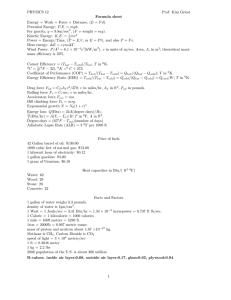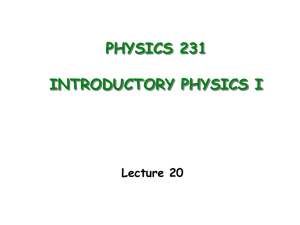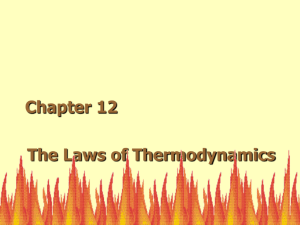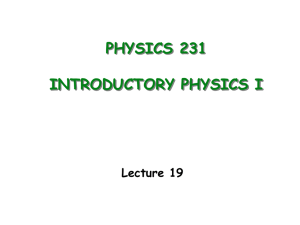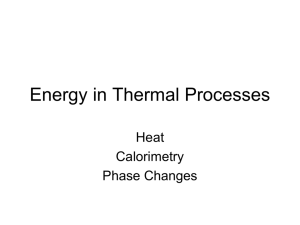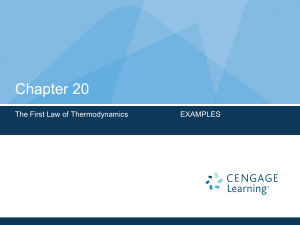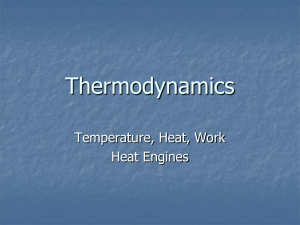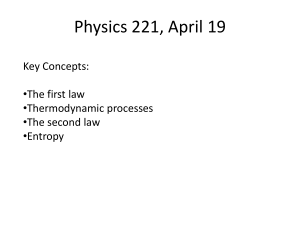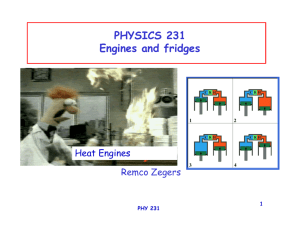Chapter 12 The Laws of Thermodynamics
advertisement
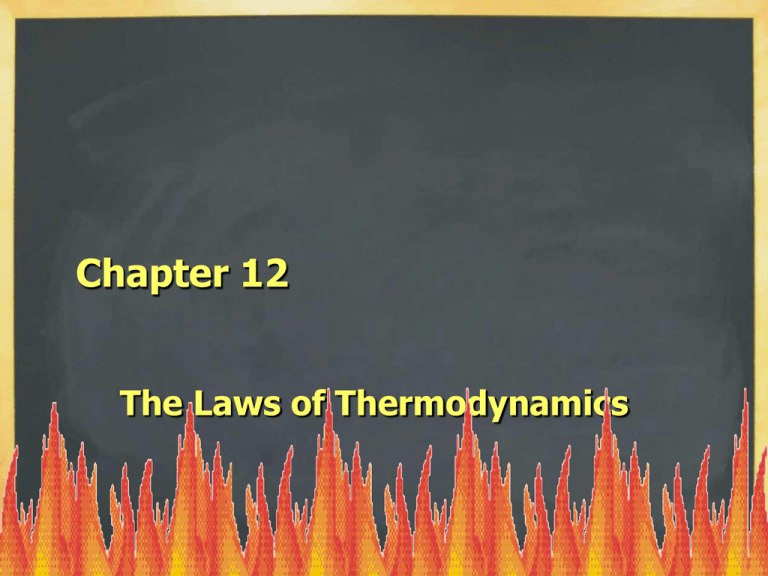
Chapter 12 The Laws of Thermodynamics Principles of Thermodynamics Energy is conserved FIRST LAW OF THERMODYNAMICS Examples: Engines (Internal -> Mechanical) Friction (Mechanical -> Internal) All processes must increase entropy SECOND LAW OF THERMODYNAMICS Entropy is measure of disorder Engines can not be 100% efficient Converting Internal Energy to Mechanical U Q PV Work done by expansion W Fx, F PA, x V / A W PV Example 12.1 A cylinder of radius 5 cm is kept at pressure with a piston of mass 75 kg. a) What is the pressure inside the cylinder? 1.950x105 Pa b) If the gas expands such that the cylinder rises 12.0 cm, what work was done by the gas? 183.8 J c) What amount of the work went into changing the gravitational PE of the piston? 88.3 J d) Where did the rest of the work go? Compressing the outside air Example 12.2 A massive copper piston traps an ideal gas as shown to the right. The piston is allowed to freely slide up and down and equilibrate with the outside air. Choose T or F. A. The pressure is higher inside the cylinder than outside. T B. The temperature inside the cylinder is higher than outside the cylinder. F C. If the gas is heated by applying a flame to cylinder, and the piston comes to a new equilibrium, the inside pressure will have increased. F Some Vocabulary P Isobaric V o P = constant Isovolumetric P V o V = constant Isothermal o T = constant Adiabatic o Q=0 P P V V Example 12.3 Outside Air: Room T, Atm. P A massive piston traps an amount of Helium gas as shown. The piston freely slides up and down. The system initially equilibrates at room temperature (a) Weight is slowly added to the piston, isothermally compressing the gas to half its original volume (b) A. B. C. D. E. P b ( > < = ) Pa Tb ( > < = ) Ta Wab ( > < = ) 0 Ub ( > < = ) Ua Qab ( > < = ) 0 U Q PV W PV Vocabulary: Wab is work done by gas between a and b Qab is heat added to gas between a and b Example 12.4 Outside Air: Room T, Atm. P A massive piston traps an amount of Helium gas as shown. The piston freely slides up and down. The system initially equilibrates at room temperature (a) Weight is slowly added to the piston, adiabatically compressing the gas to half its original volume (b) A. Pb ( > < = ) Pa B. Wab ( > < = ) 0 C. Qab ( > < = ) 0 U Q PV D. Ub ( > < = ) Ua W PV E. Tb ( > < = ) Ta Vocabulary: Wab is work done by gas between a and b Qab is heat added to gas between a and b Example 12.5 Outside Air: Room T, Atm. P A massive piston traps an amount of Helium gas as shown. The piston freely slides up and down. The system initially equilibrates at room temperature (a) The gas is cooled, isobarically compressing the gas to half its original volume (b) A. B. C. D. E. P b ( > < = ) Pa Wab ( > < = ) 0 Tb ( > < = ) Ta Ub ( > < = ) Ua Qab ( > < = ) 0 PV nRT U Q PV W PV Vocabulary: Wab is work done by gas between a and b Qab is heat added to gas between a and b Work from closed cycles Consider cycle A -> B -> A WA->B -WB->A Work from closed cycles Consider cycle A -> B -> A WA->B->A= Area Work from closed cycles Reverse the cycle, make it counter clockwise -WB->A WA->B Example 12.6 a) What amount of work is performed by the gas in the cycle IAFI? W=3.04x105 J b) How much heat was inserted into the gas in the cycle IAFI? Q = 3.04x105 J V (m3) c) What amount of work is performed by the gas in the cycle IBFI? W = -3.04x105 J Consider a monotonic ideal gas. Example 12.7 a) What work was done by P (kPa) the gas from A to B? A 75 20,000 J b) What heat was added to the gas between A and B? 50 20,000 c) What work was done by the gas from B to C? 25 -10,000 J C d) What heat was added to the gas beween B and C? -25,000 J 0.2 e) What work was done by the gas from C to A? 0 f) What heat was added to the gas from C to A? 15,000 J B V (m3) 0.4 0.6 Example Continued Take solutions from last problem and find: a) Net work done by gas in the cycle b) Amount of heat added to gas WAB + WBC + WCA = 10,000 J QAB + QBC + QCA = 10,000 J This does NOT mean that the engine is 100% efficient! Entropy Measure of Disorder of the system (randomness, ignorance) S = kBlog(N) N = # of possible arrangements for fixed E and Q py px Entropy Total Entropy always rises! (2nd Law of Thermodynamics) Adding heat raises entropy S Q / T Defines temperature in Kelvin! Why does Q flow from hot to cold? Consider two systems, one with TA and one with TB Allow Q > 0 to flow from TA to TB Entropy changed by: S = Q/TB - Q/TA If TA > TB, then S > 0 System will achieve more randomness by exchanging heat until TB = TA Efficiencies of Engines Consider a cycle described by: W, work done by engine Qhot, heat that flows into engine from source at Thot Qcold, heat exhausted from engine at lower temperature, Tcold Efficiency is defined: engine : W e Qhot Since Qcold Tcold Qhot engine Qcold Qhot Qcold 1 Qhot Qhot S Q / T 0 , engines : Qhot Qcold Tcold Tcold e 1 Thot Qhot Thot Thot W Qcold Carnot Engines Idealized engine Most efficient possible W Tcold e 1 Qhot Thot Carnot Cycle Example 12.8 An ideal engine (Carnot) is rated at 50% efficiency when it is able to exhaust heat at a temperature of 20 ºC. If the exhaust temperature is lowered to -30 ºC, what is the new efficiency. e = 0.585 Refrigerators Given: Refrigerated region is at Tcold Heat exhausted to region with Thot Find: Efficiency refrigerat or: 1 Qcold Qcold e Qhot Qcold Qhot / Qcold 1 W Since S Q / T 0 Qhot engine W Qcold , refrigerat or : Qhot Qcold Qhot Thot 1 e Thot / Tcold 1 Thot Tcold Qcold Tcold Note: Highest efficiency for small T differences Heat Pumps Given: Inside is at Thot Outside is at Tcold Find: Efficiency Qhot heat pump : Qhot 1 Qhot e Qhot Qcold 1 Qcold / Qhot W Since S Q / T 0 engine W Qcold , heat pump : Qhot Qcold Qhot Thot 1 e 1 Tcold / Thot Thot Tcold Qcold Tcold Like Refrigerator: Highest efficiency for small T Example 12.9 A modern gas furnace can work at practically 100% efficiency, i.e., 100% of the heat from burning the gas is converted into heat for the home. Assume that a heat pump works at 50% of the efficiency of an ideal heat pump. If electricity costs 3 times as much per kw-hr as gas, for what range of outside temperatures is it advantageous to use a heat pump? Assume Tinside = 295 ºK. 5 T 295 245.8 K - 27 C 6
